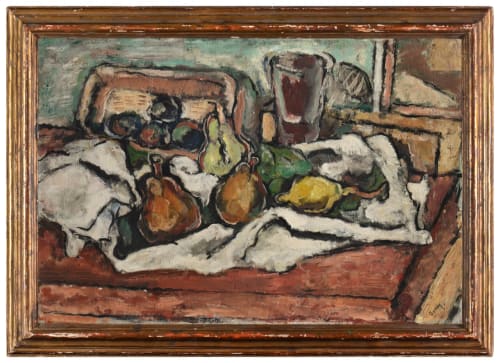ARSHILE GORKY, Still Life, 1928
Arshile Gorky is celebrated as the last great Surrealist and one of the first Abstract Expressionists. His influence on the development of modern art in America is hard to exaggerate and his works are in all the great museums in USA. This beautiful painting displays all the best characteristics of his early work.
Gorky suffered loss at a young age and his experience of the Armenian genocide had significant influence on his development as an artist. Born in Armenia in 1904, his father fled to USA to avoid the draft when Arshile was just four, and he and his mother then escaped the genocide to Russian territory, where she died of starvation in 1919. The 16 year old Gorky went to America the next year, and had an unsuccessful reunion with his father.
In the 1920s Gorky joined an art school in Boston and also lived in New York. At this time he was influenced particularly by Cezanne, which is evident in this ‘Still Life’ in both the composition and the tilted table. His widow recalled how he went to The Met often, and welcomed influences from the European masters in particular. Mrs John D Rockefeller purchased a Cezannesque fruit painting by him in 1931. In 1933, Arshile Gorky became one of the first artists employed by the Works Progress Administration Federal Art Project, which later involved Pollock and Rothko. It was in the ‘30s that he developed an interest in Surrealism. He wrote: “The stuff of thought is the seed of the artist. Dreams form the bristles of the artist's brush. As the eye functions as the brain's sentry, I communicate my innermost perceptions through the art, my worldview”.
He later became friendly with Pollock and De Kooning and was part of the New York avant-garde. Gorky was influential in developing what is sometimes called lyrical abstraction. Some of his abstract paintings have references to his memories of Armenian landscapes. The last two years of his life were particularly difficult. His studio with 30 of his paintings burned down, his wife and mother to his two children had an affair with the artist Matta and then left him, he got colon cancer, and his neck was broken in a car accident. He committed suicide in 1948, leaving an important artistic legacy.
Arshile Gorky 1904-1948
Still Life, 1928
Signed lower right: Gorky
Oil on canvas 16 3/4 x 24 in 42.5 x 61 cm
Provenance
E. Weyhe Bookshop and Gallery, New York (acquired from the artist)
Mr. John Nicholas Brown, 11 October 1929 (acquired from the above)
Private Collection
Exhibitions
Montclair, New Jersey, Montclair Art Museum, Passionate Pursuit: Hidden Treasures of the Garden State, September 1996-January 1997.
Literature J. M. Jordan and R. Goldwater, The Paintings of Arshile Gorky. A Critical Catalogue, 1982, no. 44, illustrated p. 168.
